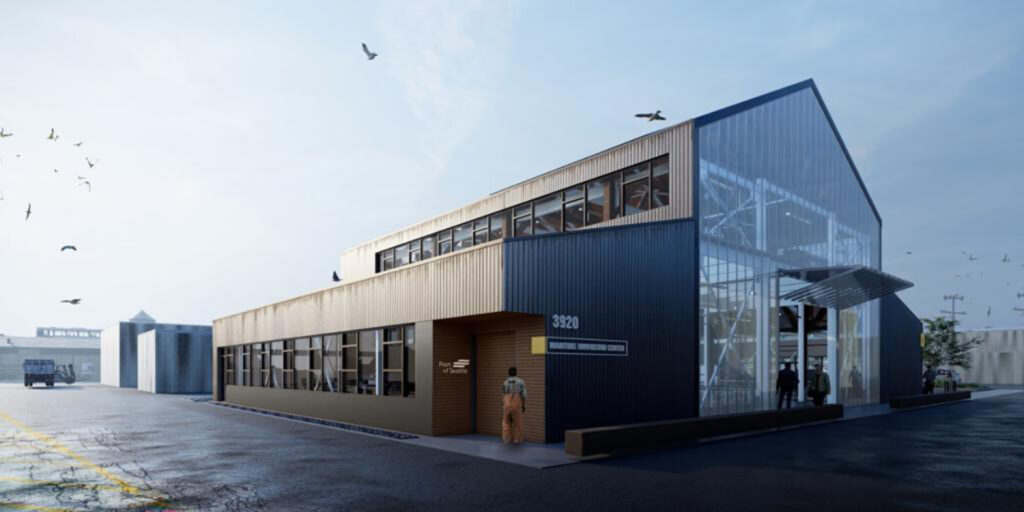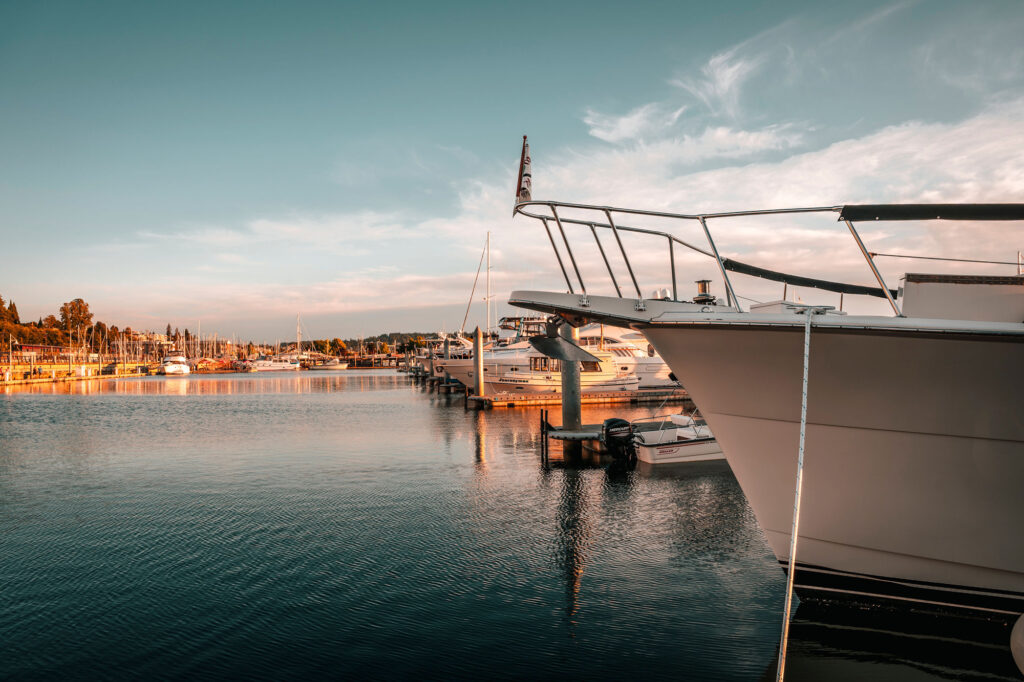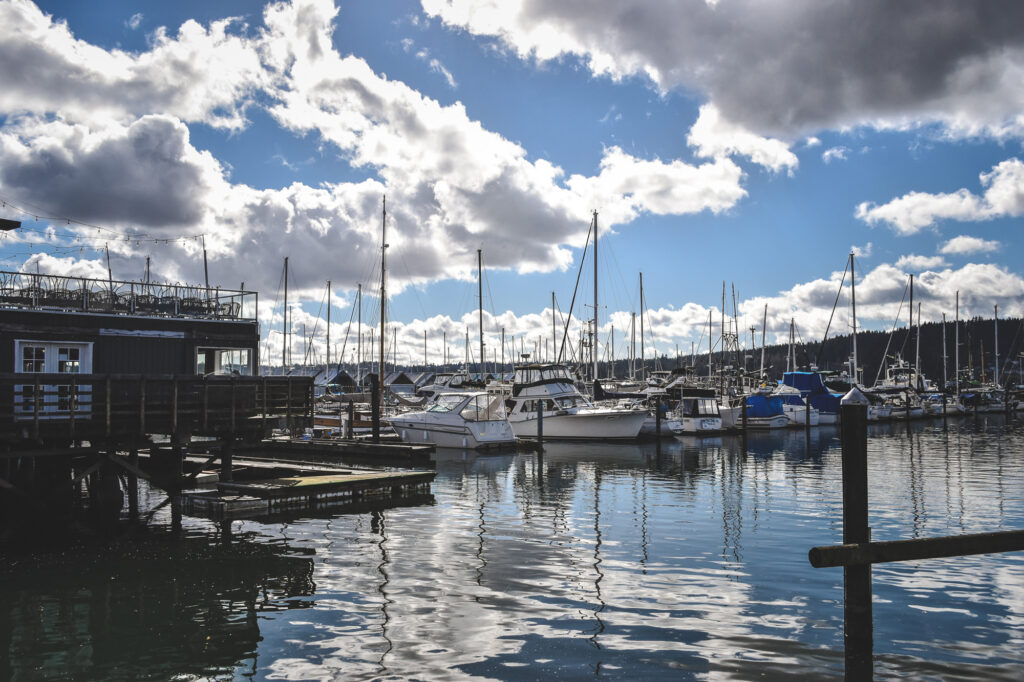
[ building for the future ]
$32.6M Finally Approved for Maritime Innovation Center at Fisherman’s Terminal
By Randy Woods / Photo Courtesy of Port of Seattle
After five years of planning and one global pandemic delay, the Port of Seattle’s promise to establish a Maritime Innovation Center (MInC) at the city’s Fisherman’s Terminal is closer to materializing. The green light, green as in money, was given for renovating a century-old building that will become MinC’s new headquarters.
The Port of Seattle approved $32.6 million in August to move forward on rejuvenating the terminal’s Ship Supply Building, first constructed in 1914 and one of the Port’s oldest existing facilities. MInC construction is set to begin at the Ship Supply Building in the second fiscal quarter of next year and is scheduled to be completed by the end of 2025.
The new MInC will become a hub for incubator and accelerator programs focused on the maritime industry, which will, hopefully, establish hundreds of startups while providing resources on how to scale up their operations. Once completed, the site will have room for equipment fabrication, business incubator offices, and anchor tenant space. MInC will also support workforce development programs to promote job opportunities in the bustling maritime industry.
“The transformation of the Port’s oldest building into a world-class center is a reflection of the Port’s commitment to investing in innovation,” said Port of Seattle Commissioner Fred Felleman.
According to a report released by the United Nations, the global infrastructure that is centered around maritime commerce, often called the “blue economy,” is estimated to be worth $1.5 trillion annually, with 90 percent of the world’s trade traveling over the ocean. Jobs within these sectors – including commercial fishing, sustainability innovations, and recreation – remain in great demand across the Puget Sound region and will be the primary new businesses likely to be developed at the MInC.
The 15,000-square-foot MInC building, itself, will be reconfigured with a certification from the Living Building Challenge (LBC), a sustainability program ensuring that the structure will use the most innovative techniques for reducing energy usage and creating connections between the built environment and nature. To date, only three other existing buildings have met the strict LBC guidelines in Seattle.
The renovation won’t end with the Ship Supply Building. Also included in the MInC plan are “companion investments” that will help improve accessibility to the rest of Fishermen’s Terminal, as well as improved landscaping and interpretive signage that will provide historical perspectives on the city’s working waterfront. Public historian Sharon Boswell will collaborate with the fishing community and Headwater People, a First Nations consultant group, to include a broad range of cultural voices to be represented in the development.
Other future long-term changes at Fisherman’s Terminal include a new Gateway Building, which will provide light-industrial space for maritime businesses, new parking lot improvements, site furniture, and lighting upgrades. The redevelopment project for Fisherman’s Terminal, which was put on hiatus during the pandemic, will resume in 2026.
For more details on the project, go to: portseattle.org/projects/maritime-innovation-center-0.

[ marina makeover ]
Second Phase to Begin in ’24 For Everett Fuel Dock Upgrade
By Randy Woods / Photo Courtesy of Port of Everett
The warm weather is over for now, but expect to see some welcomed changes when fueling up at the Port of Everett next summer. In August, the Port awarded a $7.8 million contract to begin the second stage of the long-running marina fuel dock reconstruction project.
This year, the Port completed the first stage of the renovation work, which placed 30,000-gallon underground gasoline and diesel fuel tanks at the west end of the Central Marina facility parking lot and removed older fuel tanks. Next year, the second stage will begin, including a move of the fuel dock to the east to avoid strong currents experienced at low tide.
Fabrication of the new 500-foot dock structure has already begun, with on-site work expected to take place in summer 2024. This second phase will reconfigure and enhance the dock’s layout, making it easier for boats to line up for refueling. The scope of work will also include the demolition of Central A- and B-Docks, and the installation of two additional on-dock fuel dispensers.
The plan also calls for a new attendant building, a point-of-sale system, and a new kiosk building that will include vending machines and public restrooms. The fuel dock will also have commercial and recreational pump-out locations to ensure that the waterways around Everett are kept clean.
Jeff Lindhout, the Port of Everett’s chief of marina operations, said the port has spent more than $165 million in capital improvements to the aging marina over the previous 20 years. “This upgraded fuel dock project has been a long time coming with a lot of planning and coordination,” he added.
The new fuel dock will be used not only by local recreational and commercial boaters but also for vessels operated by the neighboring Naval Station Everett, the U.S. Coast Guard, the City of Everett Police and Fire Departments, the Snohomish County Sheriff’s Office, and Native American tribes.
During this second phase of construction, the existing fuel dock will remain open for use by boaters in 2024. Once the project is completed, the old dock will be demolished and removed.
For more information, please visit: portofeverett.com.

[ refreshed & ready ]
Poulsbo’s Refurbished Floating Breakwater Set to Open This Month
By Randy Woods / Photo by Shiloh Schroeder
Boaters looking for late fall cruising to and from Kitsap County will likely be able to moor this month in the new floating breakwater at the Poulsbo Marina in Liberty Bay.
The refurbished breakwater, which has been in the works for several years, was expected to open earlier this spring until it ran into some construction delays. The breakwater is now operational but, at time of publication, was still awaiting the arrival and installation of two dozen 30-foot and 50-foot finger piers from Bellingham Marine, which were expected to come at the end of September. Once these piers are in place, the breakwater will be 100 percent complete, according to the Port of Poulsbo.
Currently, the new breakwater is anchored securely by steel piles and held up by 12-foot-wide floating concrete pontoons that were donated by Seattle’s Elliott Bay Marina. The platform will include greater public access and more transient moorage space along the new finger piers. The outside edge of the breakwater will also feature added moorage space for variable-sized boats of up to 75 feet in length.
Supported by nearly $2.5 million in grants from the Washington State Recreation and Conservation Office and the U.S. Fish and Wildlife Service, the Poulsbo breakwater now features 30A and 50A power pedestals, potable water connections, a new floating restroom, improved lighting, safety ladders, and a fire-suppression system.
Breakwaters tend to last roughly 30 to 40 years of typical maritime use, but the old Poulsbo structure had been in place for more than 60 years. The long-overdue renovation has moved the new breakwater 60 feet to the southeast and 40 feet to the south of the previous breakwater and log boom. Engineers for the new breakwater design estimate that the marina could see a 10- to 20-percent increase in wave energy due to the unrestricted flow of water underneath the structure, but its wave-attenuation performance should be in the moderate to good range.
The Port of Poulsbo said that temporary and permanent moorage will remain open for the remainder of any necessary installation work, but added that parking may still be temporarily restricted in the Anderson parking lot while utility crews make final adjustments to the breakwater.
For more details on the new breakwater, go to: portofpoulsbo.com/breakwater-replacement-project.


